Medical Marvels
In the rapidly evolving field of rehabilitation tech, Springfield College graduates are helping patients rebuild after injury and illness
Veteran Tim Conner, seated, with his new exoskeleton and the team that helped make it possible for him to be the first patient at JAHVH to be issued a personal exoskeleton. From left, JAHVH Chief of Staff Dr. Colleen Jakey, Physical Therapist Cassandra Hogan, Physical Therapist Kathryn Fitzgerald, Research Nurse Brittany Durant and Spinal Cord Injury Service Chief Dr. Kevin White.
Veteran Tim Conner, seated, with his new exoskeleton and the team that helped make it possible for him to be the first patient at JAHVH to be issued a personal exoskeleton. From left, JAHVH Chief of Staff Dr. Colleen Jakey, Physical Therapist Cassandra Hogan, Physical Therapist Kathryn Fitzgerald, Research Nurse Brittany Durant and Spinal Cord Injury Service Chief Dr. Kevin White.
AS A HIGH SCHOOL SENIOR at Lisbon High in Lisbon, Maine, Kathryn Fitzgerald ’13, DPT’15, spent a few days shadowing a physical therapist at a local clinic. The brief experience, a requirement for her senior project, would change the course of her life.
“I was hooked,” she says. “I applied only to colleges with physical therapy programs, and Springfield College was my first choice.”
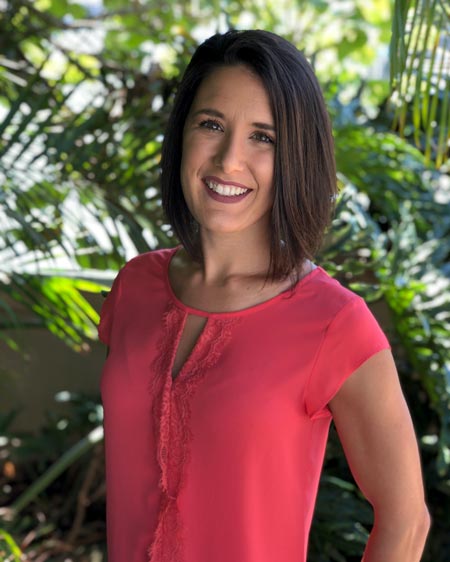
“I never thought I’d be working in robotics, but here I am.”
Kathryn Fitzgerald
In that early encounter with the field of physical therapy, Fitzgerald says, it was the activity, the variety, and the hands-on nature of the work that appealed to her. She liked the idea of a job where every day was different, where she wouldn’t be stuck behind a desk, and where she could work with people face-to-face and see the impact she was having immediately. What she didn’t expect was that her career in physical therapy—a discipline that until recently featured primarily low-tech tools such as exercise balls, treatment tables, resistance bands, and stationary bikes—would end up making her a nationally recognized expert in the use of advanced technology.
“I never thought I’d be working in robotics,” Fitzgerald says with a laugh. “But here I am.”
Now a broadly certified professional who has presented her research at industry conferences and delivered guest lectures at Springfield College and other institutions, Fitzgerald’s foray into the quickly growing field of medical robotics—culminating in her current role as a researcher at the James A. Haley Veterans’ Hospital in Tampa, Fla.—has put her in the good company of a number of other Springfield College graduates.
ALTHOUGH NOT ALL of them are doctors or therapists, all have worked in some capacity with similar devices, and all continue to play a role in the development and successful application of these life-changing technologies. Among them are Andy Dolan ’01, vice president of marketing and reimbursement at ReWalk Robotics; Loren Wass ’83, a former ReWalk colleague of Dolan’s who is now chief commercial officer at Bionik, Inc.; and Fitzgerald’s mentor at the Tampa VA, Dr. Steven Scott ’72.
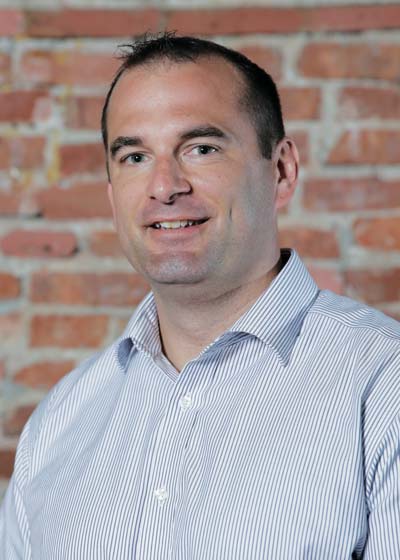
Andy Dolan 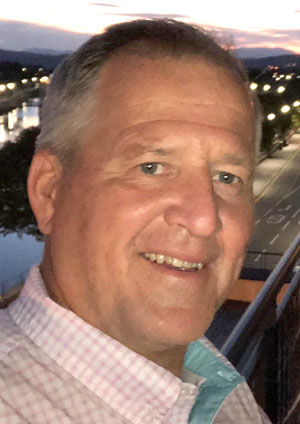
Loren Wass 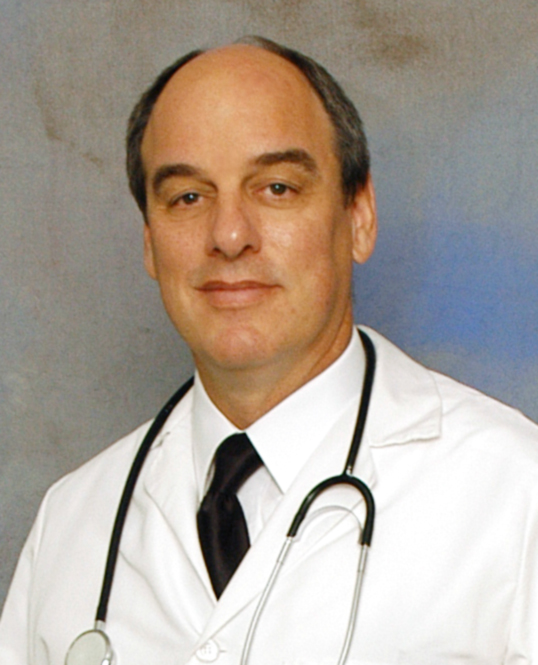
Dr. Steven Scott
The 2009 recipient of the Springfield College Distinguished Alumnus Award and the Tampa VA’s chief of physical medicine and rehabilitation, Scott says the transformations being achieved with the newest rehabilitation technologies are nothing short of miraculous.
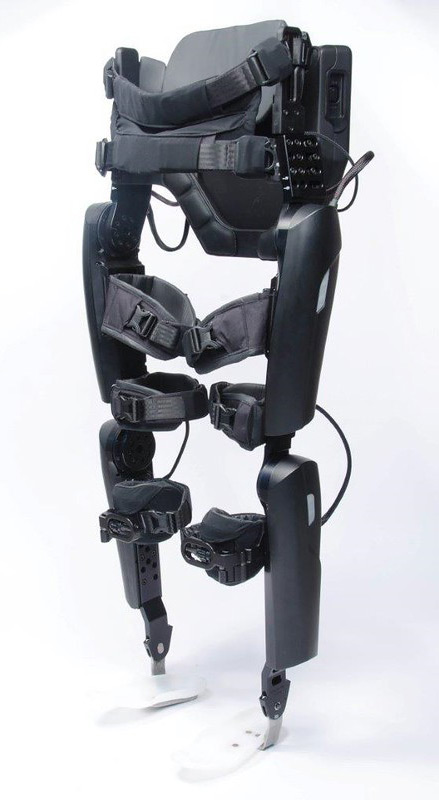
“These exoskeletons are allowing people to do things that we never thought possible … you can take someone who may have been paralyzed for seven or eight years, and, in the first treatment, you can get them up and walking.
Dr. Steven Scott
“These exoskeletons are allowing people to do things that we never thought possible,” he says. “You can take someone who may have been paralyzed for seven or eight years, and, in the first treatment, you can get them up and walking. That not only gives them hope, it changes their whole concept and thinking about what they may have in store in the future. And these current exoskeletons are like the old Ford Model As—this is just the second generation. They are improving, they are getting more durable, and they are starting to go into people’s homes. It’s going to take time, but it’s developing and it is going to be a way forward.”
That way forward will be paved in part by physical therapists like Fitzgerald. Currently engaged in a fellowship at the VA, she is working on a federally funded research study that involves training veterans or active-duty military personnel who are victims of spinal cord injuries to use the exoskeletons. With the robotic tools emerging as an upright alternative to wheelchairs, the study aims to assess the devices’ efficacy in improving patients’ physical and mental health.
UNTIL THE COVID-19 pandemic brought a temporary halt to the study and to face-to-face contact with patients, Fitzgerald was juggling this role with that of a part-time outpatient physical therapist at Fit4Life Physical Therapy and Personal Training as well as a part-time home health physical therapist at Florida Rehability Home Health—both located in Tampa. The varying tasks involved with these jobs, Fitzgerald points out, have natural synergies.
“The advantage of being a physical therapist in this role,” Fitzgerald says, “is that I know a lot about walking and gait, and those principles of normal walking mechanics are the foundation for how these robotics are built. They’re trying to replicate normal walking mechanics—which, as a physical therapist, I know like the back of my hand. You don’t have to be a physical therapist to work with robotics, but it helps, because we already have that background.”
Fitzgerald’s interest in studying and healing neurological traumas such as spinal cord injuries was sparked during her final rotation as a doctoral candidate at Springfield College. Serving at an acute neurological rehabilitation facility in Schenectady, N.Y., she says, her imagination was captured by the detective work involved, as well as the opportunity to work closely with patients on an ongoing basis.
“With neuro,” she says, “It’s like a puzzle. You could see six different people who had had a similar stroke, and all of them might recover differently or do better with different therapies. You have to figure out where the deficits are and what’s going to work for that person. I liked the autonomy to really treat every person totally differently, and I like that you can get more time with your patients. An inpatient setting at the hospital is different than seeing someone in a clinic and sending them home and hoping they do their exercises. When they’re here for a while, you can check up in real time on the things that you’re doing for them, to see what’s working.”
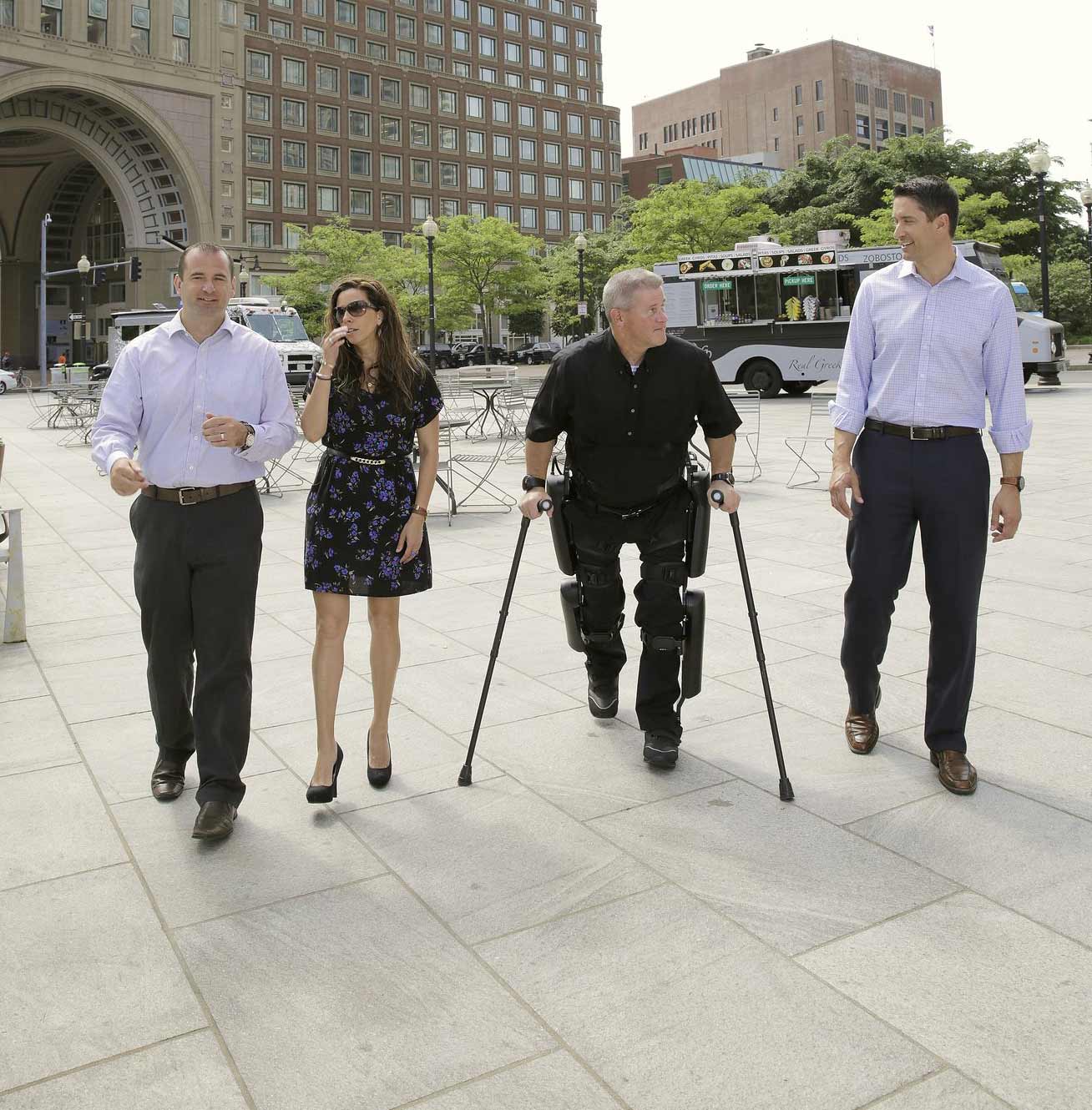
At left, Andy Dolan, vice president of marketing and reimbursement at ReWalk Robotics
THE FIRM THAT BUILDS the device Fitzgerald is using in the study is the Marlborough, Mass.-based ReWalk Robotics, a leader in the rehabilitation-tech market and a company where, over the years, several Springfield graduates have been a part of the team. Its “ReWalk Personal 6.0” —the first exoskeleton to receive FDA clearance for personal and rehabilitation use in the U.S.—is a wearable robotic exoskeleton that provides powered hip and knee motion to enable individuals with spinal cord injury to stand upright, walk, turn, and climb and descend stairs. The company’s newer “ReStore” device is a powered, lightweight, soft exo-suit intended for use in the rehabilitation of individuals with lower limb disability due to stroke.
As vice president of marketing and reimbursement, Andy Dolan’s role at ReWalk involves both educating potential users about the benefits of the company’s devices and persuading clinicians, insurance companies, and regulators at the Food and Drug Administration that such devices can find a viable place in the market—finding ways to demonstrate, essentially, that they can be produced at a cost that is not prohibitive, that they are safe, and that they are effective enough to justify public and private insurance coverage.
“Even though it’s a very different treatment method,” Dolan says, “it’s still a Class II medical device,” meaning the FDA has designated it as having moderate to high risk to the patient or user. Thus, Dolan explains, “It still follows a lot of the same guidelines. But anytime you have something new or disruptive, you really have to change minds. We’ve spent a lot of time and energy educating people on the why and the how of these devices, and what we say over and over again is that it’s a therapeutic device. It’s an exercise device. And with limited usage, a person can get great benefits.”
Dolan describes one such patient, a paralyzed veteran who uses a ReWalk Personal 6.0 device. In four years, Dolan says, the patient has gained muscle strength, has lost 65 pounds, has begun to play wheelchair sports, and has been able to reduce his dependency on opiates to control pain.
“The device helps with your core and stability, and that has taken away his back pain,” Dolan says. “With the sports, now he has the psychosocial benefits of being with people, feeling good and being more engaged, more energetic. These are the types of things we get to hear about all the time. It’s great, and it’s really what the person makes of it.”
Dolan sees a connection between the benefits he describes and the balanced approach to health and wellness he learned at Springfield. It was that philosophy, he says, in addition to the knowledge and practical training he gained, that set the stage for his career.
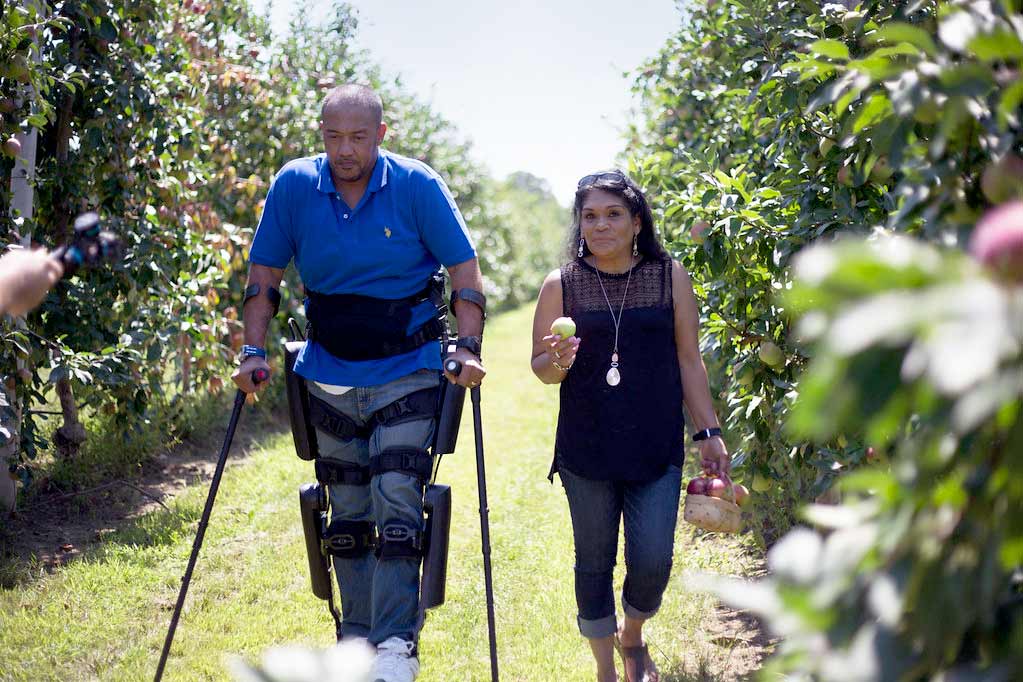
Dolan sees a connection between the benefits he describes and the balanced approach to health and wellness he learned at Springfield. It was that philosophy, he says, in addition to the knowledge and practical training he gained, that set the stage for his career.
Promotional shot of the ReWalk Personal 6.0 System
“At Springfield College, I was an athletic training major, so I learned a very physical, hands-on approach to understanding the body and treating it, versus a pharmaceutical or biotech approach,” Dolan says. “When I came across this device, it really fit the model of a very different way to think about treating people—and actually a very different way to approach health care. It’s not surgery and it’s not a drug. It’s something that is a little more oriented toward overall wellness. So it seems like a very positive step.”
HIS FORMER COLLEAGUE, Loren Wass, who in 2019 left ReWalk to join Watertown, Mass.-based Bionik, agrees. Though the bulk of his time is spent on sales and development, there is a deep satisfaction, he says, in knowing that, ultimately, his work will contribute to the healing of people who are injured—many of them veterans.
“It is very, very rewarding,” he says. “And that’s one of the things that goes back to the Springfield College and Humanics with the balance of mind, body, and spirit. One of the things that sticks with you is, yes, I sell a product; I want to make a sale; and that helps my income and helps my company grow. But at the end of the day—and this is something Springfield really keeps in your head when you’re a student there—yes, business is important, but at the end of the day it’s about the patients.”
In this role as chief commercial officer at Bionik, Wass is responsible for managing all commercial aspects of the company, dividing his time between corporate offices in Toronto and Watertown and—until the recent disruption caused by the Coronavirus—spending days at a time traveling nationally and internationally to visit trade shows, client hospitals, and sales prospects. He coordinates management and departments at the company; studies market dynamics at the territory, regional, national and international levels; works with engineers to develop products that will fill a niche in the market; and works with other executives to build successful sales strategies.
One of the company’s most exciting recent developments, he says, is a product that combines the innovative robotics Bionik designs with cloud storage of massive amounts of data. This, he points out, will allow big clinics, hospitals, and other large entities that use the device to add powerful new reporting tools to their application of the Bionik technologies.
“Springfield College is a unique school in the way that it builds your ability to interact with people. It’s a very close-knit place, and you’re managing and working with people all the time—they really push that: being engaged, being involved. If you look at other schools, whether it’s an engineering school or science-based or whatever, they often don’t facilitate that community and push you to build relationships with people.”
Loren Wass ’83
“With InMotion Connect,” Wass says, “different rehab spaces will be able to connect all their devices to the cloud and then pull data from each one into a dashboard so that they can look at things like, how often is a therapist using it? How many patients are using it? What’s the average time a patient is on it? This will allow them to standardize care and get better results.”
While Wass has a hand in the development of such products, much of his time, he says, is simply spent educating clinical workers and patients about how to use his company’s devices.
“My job is to drive interest in products,” Wass says. “It’s a social role.”
The campus climate he found at Springfield, he says, played a part in preparing him for the position at Bionik as well as for other jobs he has held in the medical rehabilitation sphere.
“Springfield College is a unique school in the way that it builds your ability to interact with people,” he says. “It’s a very close-knit place, and you’re managing and working with people all the time—they really push that: being engaged, being involved. If you look at other schools, whether it’s an engineering school or science-based or whatever, they often don’t facilitate that community and push you to build relationships with people. What I do in sales is very much about interacting. So, it set me up perfectly for this career.”
BACK AT THE VA, Fitzgerald shares a similar perspective.
“Springfield College is where I built the foundation of being an active person,” she says, “of knowing how to stay engaged, how to take care of myself and my body. Obviously, that translates directly into what I do as a physical therapist. But, I also feel like Springfield does a really great job teaching communication skills—how to talk to people who are different than you and how to communicate. It’s ingrained in the culture there that you’re accepting of other people and you have good communication skills and you make others feel included. And again, that translates directly into what I do every day.”
In the nearly four years since she took on her current role at the VA, Scott says, Fitzgerald has quickly become a leading authority on the use of exoskeleton technology.
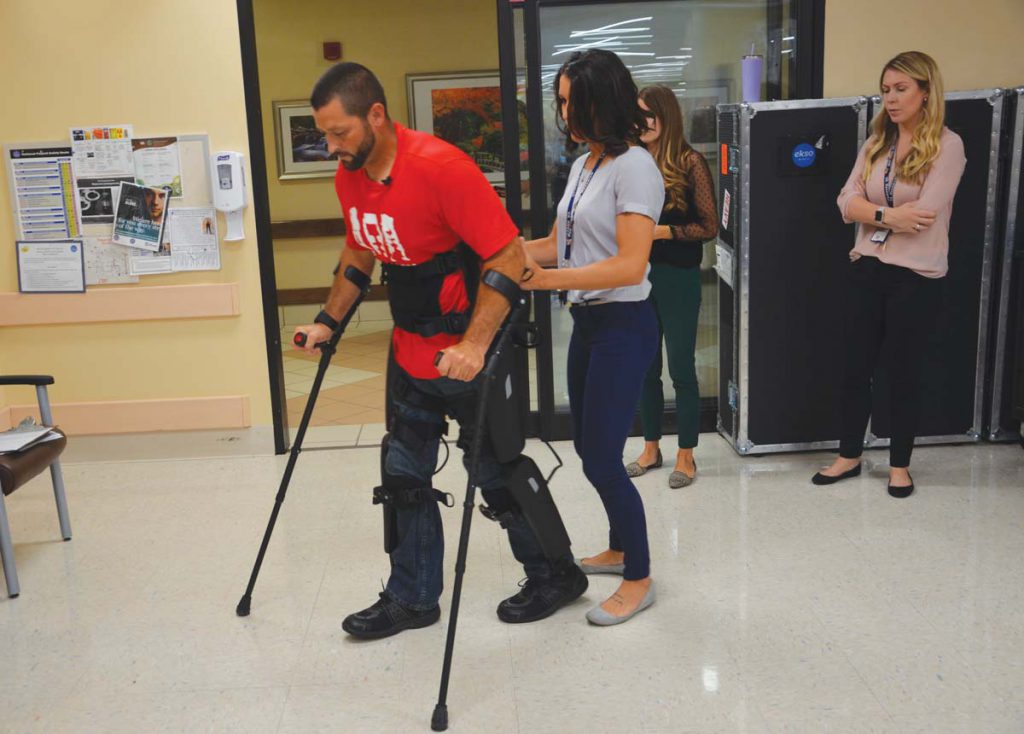
“Kathryn has developed an expertise that other therapists don’t have,” he says. “And these devices are a little bit expensive, so it’s good to have someone who knows what the heck they’re doing. It’s sort of like trying to teach someone to drive a car—but these things are worth more than most cars. It takes a very complex skill set to do what she does.”
As the technology that drives the devices evolves, Scott says, so, too, do the techniques and skills required to teach their use effectively. The work Fitzgerald is doing, he notes, is breaking new ground.
“It’s sort of like your first astronauts going into space,” Scott says. “They go up and go around the earth a couple of times, and then they can teach the next generation to go around 50 times, and then the third generation maybe goes to the moon and back. Kathryn is among the pioneering therapists who are going to take the technology to a new level that will be even more beneficial.”
The successes, Fitzgerald says, have a compounding effect, and she is particularly excited about the ways small advances in technology can have outsized results in patients’ lives.
“The really cool thing,” she says, “is that this technology is starting to transition to people taking these devices home and wearing them in the community. And, the VA has committed to providing veterans with this technology as they qualify for it. There are people who are walking around their kids’ school in a robot who would otherwise be in a wheelchair.”
Such advances, Scott says, are just the beginning. He envisions a future where exoskeletons with smart sensors, smaller battery packs, and links to artificial intelligence will be standard tools of rehabilitation, allowing patients who currently still have to rely on therapists and clinics to become fully independent. And he is particularly proud of the fact that the VA can provide the current technologies to injured servicemen and women.
“Our mission is to help those who serve our country,” he says. “In many ways, they are the true heroes of our country. They gave our freedom to us, so I want to give them freedom—freedom to walk, freedom to think, freedom to re-enter society or to go back and serve again if they choose to. I feel like that is my purpose. It’s not about making a lot of money. It’s not about anything like that. It’s about treating them holistically, it’s about treating them with a knowledge of all the different ingredients that create real wellness. And, I think that’s a lot of what Springfield College is all about: serving other people.” ![]()


